| |||||||
| Search Forums |
| Advanced Search |
| Go to Page... |
 |
| Search this Thread |  39,879 views |
| | #1 |
| Senior - BHPian Join Date: Oct 2014 Location: MH02 to MH46
Posts: 1,612
Thanked: 6,596 Times
| Understanding 4x4 and Modern 4WD driving aids Modern 4WD or 4x4 vehicles are equipped with various driving aids, which help the driver in many ways. Although this ruins the driving skill, this is the present and future, and almost all modern 4WD’s come with various bells and whistles which are electronically controlled. How is this achieved? The vehicle is equipped with various sensors, which provide information to the ECU and the vehicle acts accordingly. Some of the data is supplied in milliseconds. Many 4WD’s are loaded with modern technology like ESP, Locking differentials, centre clutch, BTC, ETC, which aid the driver during four wheeling. Lets look at each of them in details. Wherever possible I have included a relevant video for better understanding. Before we move on to the 4WD Endeavour, lets understand difference between various driving aids and fitments in an AWD or 4WD vehicle. Index:
Last edited by ruzbehxyz : 2nd March 2022 at 14:50. |
| |  (39)
Thanks (39)
Thanks
 |
| The following 39 BHPians Thank ruzbehxyz for this useful post: | AdityaDeane, asingh1977, AutoNoob, BalaChakravarth, BalaSNKL, Bibendum90949, DogNDamsel12, Dr.AD, drjaygoyal, DrVardhan, Fuldagap, GTO, gunin, haisaikat, HTC, jithin23, kkstile, maddyg, Mahesh Prasad, megazoid, morphious, NarediAni7518, Nature&Me, neel@makrand, One, Potatopoco, Prakritij, Ranger747, RedTerrano, rithik_wadhwani, Samba, Sheel, sidhnik, SILVER-ARROW, SS-Traveller, Surprise, Sushil Pingua, theexperthand, WhiteKnight |
| |
| | #2 |
| Senior - BHPian Join Date: Oct 2014 Location: MH02 to MH46
Posts: 1,612
Thanked: 6,596 Times
| re: Understanding 4x4 and Modern 4WD driving aids AWD vs 4WD: Source: https://topyups.com/4wd-vs-awd-cars-suvs/1254/ AWD: All-wheel drive, or AWD, refers to a system where all four wheels get torque and can gain traction independently of each other. As the name implies, AWD systems power all four wheels all the time. In practice, there are actually two types of AWD. One which drives all the wheels continuously, referred to as full-time AWD. The second, often called part-time AWD or automatic AWD, operates most of the time in two-wheel-drive mode. In these systems, power is delivered to all four corners only when additional traction control is needed. AWD systems, both full-time and part-time, generally operate with minimum input from the driver. Some offer selectable modes that allow a degree of control over how much power goes where, often called Adaptive Terrain management. All the wheels get torque through a series of differentials, viscous couplings and/or multi-plate clutches, which help distribute power to the wheels so that the car's traction is optimized. AWD works well in a variety of conditions like rain, snow, light off-roading, but it is generally considered a lesser choice by the more serious off roader. 4WD: Like AWD, 4WD is also designed to send torque to all four wheels to increase traction when needed. But 4WD systems tend to be more robust than AWD ones and can generally handle more rugged terrain. They are equipped with a Low Range Transfer case and some with lockable differentials. 4WDs are also differentiated into Full time and part time. Full-time 4WD operates as a full-time AWD system does, with all four wheels receiving power on a continuous basis Eg. Ford Endeavour. In some designs, the driver may have the option of controlling how power is sent to the front and rear axles through selectable modes. This type can most often be found in SUVs that are designed to work in extreme conditions. In this case, the vehicle is typically driven by two wheels, most often in the rear. The driver needs to make the decision to engage 4WD when needed and either push a button or shift a lever. Some systems also allow the driver to lock the vehicle's differentials for extra traction in extreme off-road conditions. Most of these vehicles are equipped with 2H, 4H and 4L, where 2H is only for on road terrain. Eg. Ford Ranger. Above explantion should not be treated as a definite system for each type of car but treated as principles of AWD and 4WD. Modern vehicles are more complex and different manufacturers have different systems in their cars, which are upgraded from time to time. Last edited by ruzbehxyz : 2nd March 2022 at 14:51. |
| |  (39)
Thanks (39)
Thanks
 |
| The following 39 BHPians Thank ruzbehxyz for this useful post: | AdityaDeane, arjunsatheesh, AROO7, ashking101, AtheK, Bibendum90949, BopsKA12, dhanushs, Fuldagap, GTO, gunin, Jeash.vk, jomson13, karthikd21, Kashish, kosjam, KrisTvpm, Livnletcarsliv, LordSharan, lovetorque, MechAJ, MyLife_MyCar, NarediAni7518, Nature&Me, neel@makrand, Potatopoco, Prakritij, rbalachandar, RedTerrano, Samba, Sheel, SILVER-ARROW, sridhar-v, SS-Traveller, SukhamritR, Surprise, tchsvy, theexperthand, Zangetsu |
| | #3 | |
| Senior - BHPian Join Date: Oct 2014 Location: MH02 to MH46
Posts: 1,612
Thanked: 6,596 Times
| re: Understanding 4x4 and Modern 4WD driving aids Differentials:If the vehicle travels in an absolutely straight line, the two wheels on an axle will rotate at the same speed. However in reality this is not practical as vehicles need to turn without causing damage to the vehicle components and to the tyres. This is where the differentials come into play. The differential is mainly a system of gears that allows the wheels on an axle to turn at different speeds so that the vehicle can take turns without putting much pressure or slipping the tyres. The inside wheels move a shorter distance as compared to the outer wheels. If the axle does not allow the wheels to spin freely, the wheel of the tyre will drag on the ground. Hence this is essential when the vehicle turns, causing the wheel to move outside the turning curve to roll further and faster than the other. Most vehicles have front and rear differentials, while centre differential is mainly found in AWD or 4WD vehicles. In some modern 4WD vehicles, the centre differential is substituted by a center clutch, which locks and unlocks electronically and has no input from the driver. 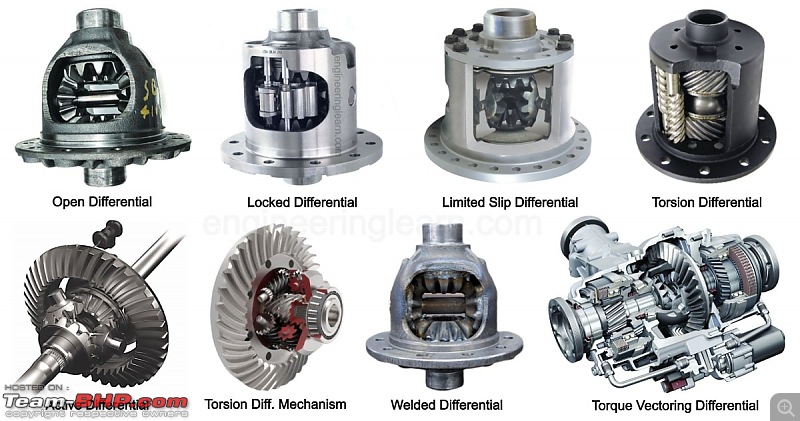 Source: https://engineeringlearn.com/what-is...with-pictures/ Following are the types of differential: Quote:
Last edited by ruzbehxyz : 1st March 2022 at 12:34. | |
| |  (29)
Thanks (29)
Thanks
 |
| The following 29 BHPians Thank ruzbehxyz for this useful post: | AdityaDeane, ArijitGupte, ashking101, AutoNoob, BopsKA12, CEF_Beasts, dhanushs, DogNDamsel12, Fuldagap, gischethans, GTO, gunin, haisaikat, JD_404, Livnletcarsliv, lovetorque, MyLife_MyCar, Nature&Me, neel@makrand, Prakritij, pratika, Ranger747, RedTerrano, Samba, Sheel, SILVER-ARROW, Surprise, theexperthand, TheHkrish |
| | #4 |
| Senior - BHPian Join Date: Oct 2014 Location: MH02 to MH46
Posts: 1,612
Thanked: 6,596 Times
| re: Understanding 4x4 and Modern 4WD driving aids Transfer case:A transfer case is a specialist component of the drivetrain of a 4WD vehicle and one of the most important components. The transfer case transfers power from the transmission to the front and rear axles by means of drive shafts / propeller shafts. It contains one or more sets of low range gears for off-road use often called as 4x4L or 4L. Low range gears allow the vehicle to drive at much slower speeds while still operating within the usable power band / RPM range of the engine. This also increases the torque available at the axles. Low-range gears are used for very inclement road conditions, towing a heavy load slowly, driving on tough terrains and extreme off-road manoeuvres such as rock crawling. This feature is often absent in AWD vehicles. Source: Autodata Training Last edited by ruzbehxyz : 2nd March 2022 at 14:52. |
| |  (24)
Thanks (24)
Thanks
 |
| The following 24 BHPians Thank ruzbehxyz for this useful post: | Ace F355, AdityaDeane, ArijitGupte, ashking101, asingh1977, AutoNoob, BopsKA12, CEF_Beasts, Fuldagap, gischethans, GTO, gunin, Livnletcarsliv, mugen_pinaki27, MyLife_MyCar, neel@makrand, Prakritij, Ranger747, RedTerrano, Samba, Sheel, SILVER-ARROW, Surprise, theexperthand |
| | #5 | ||
| Senior - BHPian Join Date: Oct 2014 Location: MH02 to MH46
Posts: 1,612
Thanked: 6,596 Times
| re: Understanding 4x4 and Modern 4WD driving aids Various Driving aids:As mentioned above, modern 4WD and AWD vehciles are equipped with many types of driver aids. Most of these are interlinked. Lets look at each component separately. Electronic Stability Control (ESC): Electronic Stability Control (ESC), also referred to as Electronic Stability Program (ESP), is a computerized technology that improves a vehicle's stability by detecting and reducing loss of traction. ESC monitors your vehicle’s behaviour, taking into account the steering angle, acceleration, yaw sensors etc., and automatically applies brakes to individual wheels if it detects under or oversteering. Source: MyCarDoesWhat Here is a list of the names various manufacturers use for their stability control systems around the world:- Quote:
ESC is composed of the following safety features:- Traction Control: Also called Engine Traction control, this adjusts engine power to the drive wheels to help maximise the traction or grip they have on slippery or loose driving surfaces at any speed. Brake pressure is also applied in certain conditions. If your vehicle is equipped with Traction control, it should always be kept on in almost all conditions. However, there are some circumstances where it’s advisable to disable the system. If the traction control keeps detecting a spinning wheel in certain conditions, it will keep reducing the power which won’t help in giving the car any momentum. In other words, this feature is not very good during off road, as you need certain amount of wheel spin and momentum, while traction control will reduce momentum. Example: While stationary on a signal in wet conditions, if you floor the accelerator, the drive wheels spin hard before the car actually takes off. Initially the engine powers the wheels as per the accelerator and then the traction control detects wheels spin, so the engine reduces power on the drive wheels and the car moves forward. This is Engine Traction Control. If a driving condition activates either the Stability control or traction control, you may experience the following: 1. The traction control light flashes on the console. 2. Vehicle slows down. 3. Reduced engine power. 4. Vibration in brake pedal. 5. Stiffer brake pedal. Brake Traction Control: During off road, there may be a situation when one wheel on an axle is in the air or just above the ground (no traction) and the other wheel has traction. In this situation, the engine provides power to the spinning wheel which is very less and so the other wheel on the same axle also receives same amount of power due to the differential. This results in the vehicle not moving, as this power produced is not sufficient for turning the wheel which has traction. In this condition, the BTC kicks in automatically and brake is applied to the spinning wheel. This causes resistance on the wheel and hence torque is increased on this wheel. At one point, the torque is increased to such an extent, that the traction wheel gets enough torque to move the vehicle ahead. Point to remember is that BTC gets automatically disabled if you lock your differentials (if provided), as during this time, each wheel on the same locked axle will get the same amount of torque. During off road, the driver needs to decide on Locked Differential vs BTC as per which type of 4WD he owns. Some 4WD vehicles have Rear Differential lock eg. Ford Endeavour, while some have front and rear. The Mercedes G Wagon has three differential locks – Front, Centre and Rear. Source: Robert Pepper. ABS: Anti-Lock Braking System (ABS) prevents your wheels from locking when you have to brake suddenly. ABS electronically ‘pumps’ the brakes several times per second when sensors detect the wheels locking to modulate brake pressure. This is a very good safety feature and introduced in budgeted cars as well. From April 2019, ABS has been made mandatory on all cars and two wheelers above 125cc sold in India. Electronic Brake force Distribution (EBD): EBD is an extension or sub-system of the Anti-Lock Braking System (ABS). It ensures that the right amount of force is applied to each wheel. It automatically balances the amount of brake force between the front and rear wheels before ABS becomes active, if your rear wheels lock. It also optimises brake performance by adapting brake force under different loads, whether it’s extra passengers, lots of cargo or both. Brake Assist: Also known as Emergency Brake Assist (EBA) is another piece of car braking technology. As the name suggests, it is responsible to assist the driver in emergency stop situation. It detects when you’ve hit the brakes suddenly but not hard enough to come to a fast stop. It then applies the pressure needed to the brakes to maximise speed reduction and help reduce the stopping distance. Once you release the brake pedal, normal braking mode is restored. ABS, EBD and BA explained. Source: Lexus Drivers Hill Launch Assist: Driving off on a hill can put the best driving skills to the test. Especially if someone has stopped centimetres from your bumper. Hill Launch Assist takes the worry out of rolling, even in the tightest squeeze. The sensors in an accelerometer measure the longitudinal incline of the slope. If your car is on an incline that could cause it to roll backwards, Hill Launch Assist automatically activates. When you take your foot off the brake to put it on the accelerator, the system holds the brake pressure for up to 3 seconds to give you time to press the accelerator. Once the engine has enough power to stop the vehicle from rolling, Hill Launch Assist releases the brakes so you can drive away smoothly, without any roll. Works whether you’re driving uphill or down, so it’s a great help when you’re parked on an incline. Hill Descent control:  HDC is essentially a cruise control system that uses traction control technology with anti-lock brakes. When on, the vehicle will descend and apply brakes automatically without driver input to control each wheel's speed. If the vehicle accelerates without driver input, the system will automatically apply the brakes to slow down to the desired vehicle speed. Cruise control buttons can adjust the speed to a comfortable level. Applying pressure to the accelerator or brake pedal will override the HDC system when the driver requires. This is a very useful feature on steep descents or slopes. This system helps the driver to concentrate on steering since you don’t have to apply the brakes or downshift the transmission. Roll Stability Control: The system enhances your vehicle’s ability to prevent rollovers by detecting your vehicle’s roll motion and the rate at which it changes by applying the brakes to one or more wheels individually. This system is especially useful for the vehicles having the high centre of gravity (C.G.) like SUVs as they are more prone to rolling over. RSC works with the help of a gyro sensor and Electronic Stability Program (ESP/ESC) of the vehicle. The gyro sensor continuously monitors the roll angle of the vehicle with respect to ground. If it is observed that roll angle of the vehicle is exceeding its normal limit, then this system reduces the speed of the entire vehicle or specific wheels by applying brakes with the help of ESP. Some systems also possess the ability to reduce the engine power. This system reduces the chances of tumbling over the curves. RSC works only on the flat roads. This system does not take into account the rollovers caused by ditches on the roads or during offroading. Curve Control: The system enhances your vehicle’s ability to follow the road when cornering severely or avoiding objects in the roadway. Curve Control operates by reducing engine power and, if necessary, applying brakes to one or more of the wheels individually. Quote:
Last edited by ruzbehxyz : 2nd March 2022 at 15:52. | ||
| |  (30)
Thanks (30)
Thanks
 |
| The following 30 BHPians Thank ruzbehxyz for this useful post: | 2himanshu, Ace F355, ArijitGupte, AutoNoob, BopsKA12, CEF_Beasts, dhanushs, fluidicjoy, Fuldagap, gischethans, GTO, gunin, livetodrive, Livnletcarsliv, lovetorque, Nature&Me, neel@makrand, Nikhil Beke, Ponbaarathi, Prakritij, Radar, Ranger747, RedTerrano, Samba, Sheel, SILVER-ARROW, Siva Prakash, SS-Traveller, Surprise, theexperthand |
| | #6 |
| Senior - BHPian Join Date: Oct 2014 Location: MH02 to MH46
Posts: 1,612
Thanked: 6,596 Times
| re: Understanding 4x4 and Modern 4WD driving aids Manual vs Automatic for off road:This is a debatable topic and many old school off roaders prefer Manual transmission. However with the newer Auto transmissions and driving aids, the Auto transmissions are easier to drive offroad. Many Aussie websites have rated the modern Automatic transmissions as a better option. Some pros of the Automatic transmission :- 1) Driving an automatic transmission 4×4 is simply easier than driving a manual transmission 4×4. You don’t need to constantly shift gears, and are less restricted as you can keep both your hands on the steering wheel of your 4WD. 2) Automatic transmission is better suited to tackle inclines and is at a much smaller risk of stalling compared to manual transmission vehicles. You’ll only stall an automatic car if there’s a problem with the engine. 3) Automatic transmission provides a smooth driving experience. A video will explain the difference in detail. Source: Ronny Dahl Last edited by ruzbehxyz : 2nd March 2022 at 12:08. |
| |  (16)
Thanks (16)
Thanks
 |
| The following 16 BHPians Thank ruzbehxyz for this useful post: | Ace F355, AutoNoob, BopsKA12, CEF_Beasts, GTO, gunin, Nature&Me, Prakritij, Ranger747, RedTerrano, Samba, Sheel, SILVER-ARROW, SukhamritR, Surprise, theexperthand |
| | #7 |
| Senior - BHPian Join Date: Oct 2014 Location: MH02 to MH46
Posts: 1,612
Thanked: 6,596 Times
| re: Understanding 4x4 and Modern 4WD driving aids Terrain Management system: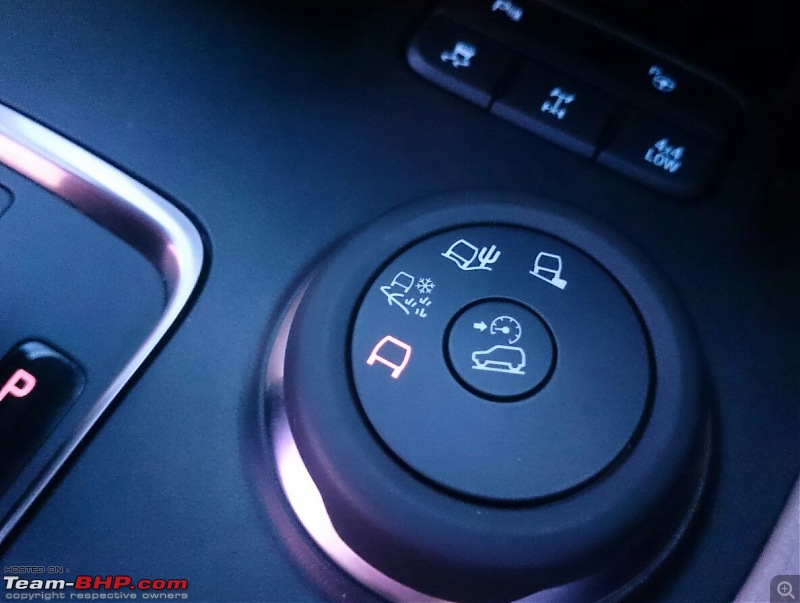 Terrain management system is an electronic system that adjusts engine torque, traction control, all wheel drive system, and other settings to provide better off-road performance on a particular surface (gravel, mud, snow, sand). Land Rover introduced a Terrain Response system on its Discovery in 2005. Later this technology was borrowed by Ford and by other manufacturers. The Ford Endeavour’s Terrain Management System offers four driving modes designed to enhance the vehicle’s capability in differing types of terrain types. These modes are Normal, Snow/Mud/Grass, Sand, and Rock. In addition the Endeavour has low range gearing, and the TMS incorporates a Hill Descent Control function.  Source: Team BHP. Further reading on Ford's TMS: https://motofomo.com.au/advice/ford-...tms-explained/ Last edited by Rudra Sen : 3rd March 2022 at 11:18. Reason: typo corrected |
| |  (13)
Thanks (13)
Thanks
 |
| The following 13 BHPians Thank ruzbehxyz for this useful post: | ashking101, BopsKA12, Fuldagap, GTO, lovetorque, Prakritij, Ranger747, RedTerrano, Samba, Sheel, SILVER-ARROW, Surprise, theexperthand |
| | #8 |
| Senior - BHPian Join Date: Oct 2014 Location: MH02 to MH46
Posts: 1,612
Thanked: 6,596 Times
| re: Understanding 4x4 and Modern 4WD driving aids Q&A for Off roading in a 4WD Endeavour:The current Ford Endeavour (Everest elsewhere) was launched in India in Jan. 2016. This article does not focus on the earlier generation of the Endeavour. The current Ford Endeavour is actually the second-generation Ford Everest (U375) which was launched worldwide in 2015. The Everest was designed in Ford's Melbourne Design Centre, Australia. Although Ford is a US Company, Ford does not sell the Everest in US as pick-up trucks like F-150, Ranger, Ranger Raptor etc., are more famous there. The second generation modified Everest is also used for a light-duty tactical vehicle for the French military, called the Arquus Trapper VT4. Link: Arquus trapper vt4 (Arquus Trapper VT4: The modified Ford Endeavour used by the French Army) The 4WD Endeavour was launched in India in three engine options:- 1) 3.2 L with 6R80 Automatic transmission and producing 470 nm of torque. Launched in 2016 and stopped in 2020. 2) 2.2 L with MT82 Manual transmission and producing 385 nm of torque. Launched and stopped in 2016 itself because of low sales. 3) 2.0 L with 10R80 Automatic transmission and producing 420 nm of torque. Launched in 2020 after introduction of BSVI in India. The 3.2 L production was stopped as it was BSIV. The 2.0 L was introduced with single turbo and hence has lesser power than the 3.2 L engine. Abroad the 2.0 L was launched with bi-turbo producing 500 nm of torque. Sadly India did not get this one. What is common among all, is the various driving aids, Low range Transfer case and Terrain Management System. Details of the 6R80 Automatic transmission of the 3.2 L engine:- This automatic transmission is a 6-speed electronically controlled transmission comprising the basic elements, main control valve body unit, torque converter, 1 solenoid valve and 6 pressure regulators. Gear selection is achieved by the control of automatic transmission fluid flow to operate various internal clutches. The TCM operates the electrical components and provides for the control of gear selection shift pressure, which increases refinement and torque converter slip. Engine power reaches the transmission by a torque converter with an integral clutch. The 6 forward gears and one reverse gear are obtained from 2 planetary gearsets. In the event of a system fault, the TCM also provides for Failure Mode Effect Management to maintain maximum functional operation of the transmission with a minimum reduction in driver, passenger or vehicle safety. In the event of a total loss of control or electrical power, the basic transmission functions P, R, N and D are retained. Also 3rd or 5th gear is retained by the hydraulic system. The gear retained is dependent upon the gear selected at the time of the failure. Transmission assembly weight: 101 kgs. Transmission operating temperature: 80 °C - 110 °C. Fluid: WSS-M2C938-A (Motorcraft® MERCON® LV AutomaticTransmission Fluid). Fluid quantity - 9 L (Wet) & 10.50 L (Dry). Gear Ratio:- 1 GR - 4.17. 2 GR - 2.34. 3 GR - 1.52. 4 GR - 1.14. 5 GR - 0.87. 6 GR - 0.69. Reverse - 3.40.  ---------xxx----------- Q&A for Ford Endeavour 4WD:- Q1) What type of vehicle is the Ford Endeavour? A1) The 4WD Ford Endeavour is a Full time 4WD with Low range and Locking Rear differentials. The 4WD system in the Endeavour is an intelligent system that continuously monitors vehicle conditions and automatically adjusts the power distribution between the front and rear wheels. It combines transparent all-surface operation with highly capable 4WD. The centre clutch electronically distributes torque front and rear (60%-40% in AUTO mode, with more power to the rear), and locks up as required. The ECU controlled centre clutch is different from the part-time 4WD system used in the Ford Ranger or Raptor which runs 2WD on road and 4WD off-road, or other vehicles which have a manually lockable centre differential. The center clutch is influenced by the TMS. The 4WD is always active and requires no driver input, however the driver can optimize more control by utilizing the terrain management switch and low range selection switch, mounted in the center console, for the correct terrain conditions.  Power distribution. Gives a faint idea when the vehicle is moving. 4WD system of the Endeavour 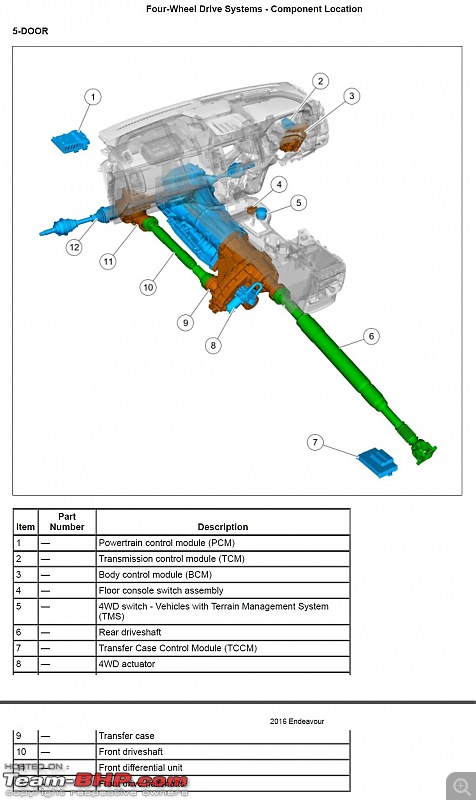 Q2) What is the load carrying capacity? A2) The Endeavour can carry 100 kg on the roof (without sunroof) and 80 kgs (with sunroof). The kerb weight (weight with diesel in tank, all oils, without passengers and accessories) of the 4WD Endeavour is about 2410 kgs. GVM is about 3100 kgs. Q3) How safe is my Endeavour? A3) Ford is known to build tough cars and this is evident across their line up. In Australia, The Everest scored a ANCAP 5-star rating in 2015 with a 35.98 out of 37 score.  Source: https://www.carexpert.com.au/car-rev...everest-review Attached is the ANCAP details. Q4) How do the electronics in my Endeavour regulate the ABS,ESC, SC etc? A4) The ABS module is the main module that governs traction control, ABS, EBD, Brake Assist etc. The ABS module receives info from various other modules and sensors. Eg. yaw rate sensor, lateral accelerometer, longitudinal accelerometer and roll rate sensor. Wheel speed information is received by the ABS module using 4 wheel speed sensors.  Q5) How to wheel speed sensors work in Endeavour? A5) On vehicles not equipped with active park assist, all 4 wheel speed sensors are active (magneto resistive) sensors that operate on the Hall-effect principle to generate a square wave signal proportional to the rotational speed of the wheel. Because these are active sensors, receiving voltage from the ABS module and then sending a varying voltage back to the ABS module, they are able to detect much lower rotational speeds than passive (magnetic inductive) sensors. Each wheel speed sensor is connected to the ABS module by 2 circuits. One circuit provides voltage for sensor operation and the other circuit provides sensor input to the ABS module. On vehicles equipped with active park assist, both rear wheel speed sensors are active, bi-directional sensors. Each of the 2 sensors contain 2 sensing elements mounted side-by-side. Because the 2 sensing elements are mounted next to each other the 2 voltage signals are slightly out of phase, which causes one element to generate a voltage signal before the other element. This allows the ABS module to not only determine wheel speed, but also wheel direction for active park assist. The front wheel speed sensor encoders are several magnets arranged in a circle around one side of the wheel bearing in alternating poles. As the bearing rotates the wheel speed sensor is exposed to alternating north-south magnetic fields. The encoder is part of the wheel bearing and is serviced with the bearing. The rear wheel speed sensor encoders use a mechanical tone wheel. Q6) When should I engage 4L? A6) As mentioned earlier 4L can only be engaged in NORMAL and ROCK mode. For tricky offroad terrains, slopes, steep descents, water crossings you must engage 4L. In 4L, the traction control switches off automatically. But which one? That’s the Engine Traction Control, the Brake Traction Control still remains effective. Q7) When should I engage ROCK mode? A7) ROCK mode can only be engaged once you engage 4L. ROCK mode is for slow speed crawling on rocks, difficult inclines on dirt tracks etc. It should not be used on wet surfaces like soft mud etc., as the vehicle will dig in further. When you engage ROCK mode, Traction control is automatically shifted off by the ECU. On the other hand, the transmission is locked in 1st gear, unless you manually use Sports mode and change to 2nd, which you may mostly never need. 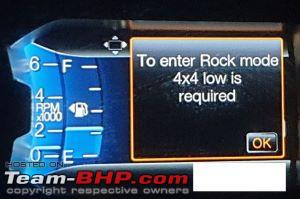  Q8) What is the maximum speed in Low Range or 4L? A8) 65 kmphr. Q9) When should I lock the Rear differentials? A9) The Rear Differentials can be locked in any mode. You must lock them if you need more traction to move out or cross a rut, climb a steep hill in a line etc. Points to remember:- A. You can activate the differential electronically and shift it “on the fly” within the differential operating speed range. However I would suggest to lock the differentials when the vehicle is stationary. B. The electronic locking differential does not engage if your vehicle speed is too high (above 35 km/h in Normal mode). C. If the electronic locking differential has difficulty disengaging, release the accelerator pedal and turn the steering wheel while rolling. D. With Rear Differential locked, the rear wheels do not get Brake Traction Control, while the front wheel still have it, but effect is less. This is very useful during off road. E. The ESC system has the ability to disable the ELD during driving maneuvers when necessary. This is a fail-safe mechanism to prevent any kind of damage. F. When the differential locking switch is pressed, if the required conditions for ELD activation are not met, the instrument cluster will display the appropriate information guiding the driver through the proper activation process. G. The locking rear differential will be automatically disengaged when ABS is used. Q10) When should I not lock the Rear differentials? A10) Do not use electronic locking differential on dry, hard surfaced roads, tarmac etc. Doing so will produce excessive noise, vibration, increase tire wear and damage to the axle. Do not engage the locking differential if you are cornering or if one rear wheel is spinning. A message may appear in the information display informing you to release the accelerator. Q11) When should I use SPORTS mode? A11) SPORTS mode is a transmission mode and not a TMS. It can be used in any condition/mode as per driver's preference. For off road, it is advisable to use SPORTS mode, as the vehicle will remain in the required gear for a longer time as desired by the driver. Q12) How do I climb a steep hill on a trail? A12) Engage 4L, S1 and move gradually. If the hill drive is longer and steep, you can start off in S2 to gather momentum. Locking the Rear Differential is the driver’s decision, but will definitely help, if you do not have to take turns. Never approach the hill in a diagonal manner as you may topple. If the hill is steep and full of rocks, then use ROCK mode, 4L, S1 and crawl up. Q13) How do I climb a steep sand hill in a desert or in sand dunes? A13) Engage 4L, S2, with/without rear locker (subject to the slope gradient and planned speed). Gather momentum before you start the climb. (Tyre pressure should be around 16 ~ 18 PSI). You will constantly get the TPMS alarm when pressure is below 20 PSI. Q14) Should I Lock the rear differential in Sand dunes? A14) The Rear locker works in Sand mode, however may not be very effective at relatively high speeds, as there will be drag during turns. However you will definitely need the rear locker on when climbing sand dune hills at relatively slow speed. Q15) Does Hill Descent Control work in Reverse also? A15) Yes. In fact you should keep the HDC On when you start climbing, so in case if your vehicle stalls or fails to climb the slope, you can engage reverse and roll down in a controlled manner using HDC. HDC works like a cruise control at crawling speed while going downhill. The driver can increase/decrease the car speed using cruise control buttons on the right side of the steering wheel. It is active at speeds less than 35 kmphr, deactivated above 40 kmphr and is turned off above 60 kmphr. The target speed is set using the cruise control buttons in 1 kmphr increments, or just use the accelerator or brake. The initial speed is determined by the gear you’re in when you switch it on. Please note HDC works with Rear lockers on as well. That means you don’t run out of engine compression braking when one rear wheel lifts in the air or looses traction as you descend a hill. Most 4WD vehicles make you choose – hill descent control or locker in.  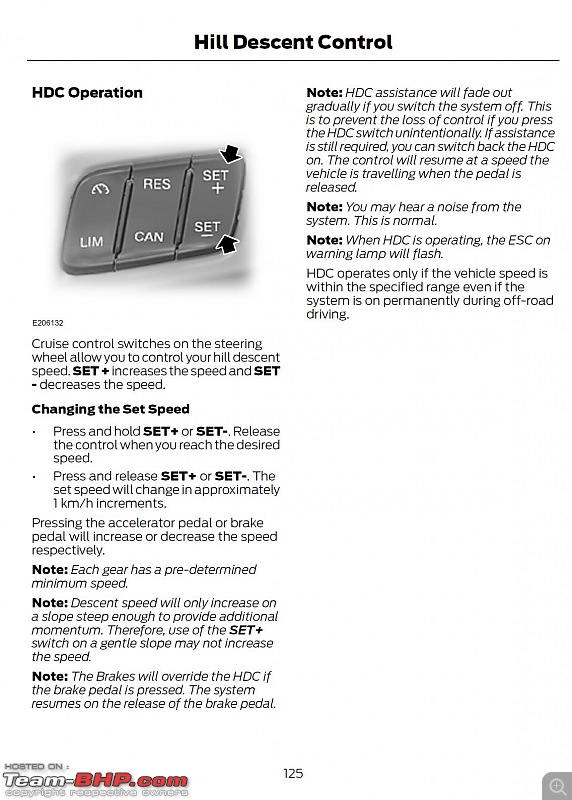 Source: Ford Owner's manual. Q16) Which mode do I use on Ice, few inches of snow? A16) SNOW/MUD/GRASS because this mode combats wheel slip, provides more traction and reduces throttle sensitivity for more control on acceleration. If you are stuck, you can engage NORMAL/ROCK, 4L, S1/D, Rear differential lock to move you out. Once you are out, revert back to previous setting. Note: Black ice, hard ice, sleet is very dangerous. With all driving aids, even the best of drivers cannot control the vehicle, if not driven properly. The Endeavour also has a disadvantage of being very heavy. So it is still the driver’s responsibility to not fully rely on electronics and control the vehicle accordingly. Q17) Can I use snow chains on my Endeavour? A17) Yes. Following is an extract from the Ford manual. Many 4WD owners suggest to use two snow chains on alternate tyres eg. Front left and rear right or vice-versa. However the Owner's manual suggests to use snow chains on the rear tyres, probably because the torque split is 60-40 on the Endeavour, with more power to the rear axle.  Source: Ford Owner's manual. Q18) Which mode do I use in “soft” snow / piles of snow? A18) SAND mode. Surprising! Yes, ideally if the snow is approximately more than 100 mm. deep. Many would use the SNOW/MUD/GRASS mode. However please note this mode is for a harder surface. Using this mode in soft snow will dig you inside further and your vehicle may get stuck. Using SAND mode will cause floatation effect and allow for more wheel slip, maintaining the momentum at the same time. However if you just have a few inches of snow on a tarmac surface or road, you are better off using SNOW/MUD/GRASS. Q19) What kind of tyres should I use for off road? A19) Any good quality AT tyres in stock size is sufficient for mild to moderate offroad and overlanding. Airing down is important depending on the terrain. Q20) What is the air pressure I should maintain in my Endeavour for various terrains? A20) As a thumb rule, you must use the manufacturer’s recommendations for on road driving.  Photo from driver's side pillar. Tyres should always be checked when cold. If you don’t have an inflator, the fuel pump tyre station should ideally be 1~2 kms from your place. After experimenting with various loads, I feel 32 psi all around (unladen) is a comfortable choice for on road driving for the Endeavour. For offroad, there’s no one-size-fits-all PSI air pressure number for every 4x4, but there are a few general rules to follow. What happens when you air down? As a general assumption, the tyre does not become broad, the foot print becomes longer, adding more friction and thus increasing the traction to each tyre when on the move. 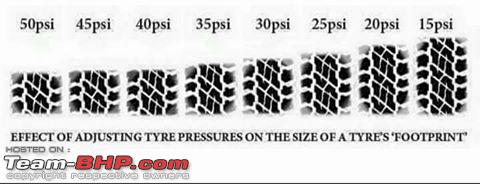 On small stony gravel, dirt tracks about 26 psi is okay. For rocky terrains about 22 psi is okay. Setting the correct air pressure for mud driving very much depends on one thing: the mud. If the mud is all slippery and slimy up top, but there’s a firm base underneath the surface, then relatively high air pressures are ideal. But if it’s all deep, with no firm base, then low air pressures will give the best result. By running at close to road pressures of around 28 psi, the tyres can cut through the top layer of mud and gain purchase on the firm base underneath, hopefully gaining enough traction to get you through the muddy sections. This is why it’s usually a good idea to stick to existing tracks when crossing a claypan, for example, as the tyres from the vehicles that have already been through will have cut through to that hard base layer under the surface. However at the same time you need to be careful of not scraping your underbody. For sand driving, you can drop your tyres down to as low as 16~18 psi without fear of pealing one off a rim, particularly if the sand is soft. This is as long as you don’t drive too fast and you don’t make any sudden steering movements. If the sand is coarse and damp, it will usually be a little harder, in which case you won’t have to lower pressures as much. Q21) Do I need to upgrade my suspension for off-road? A21) Not necessarily. You can do mild off roading and overlanding with stock suspension, but bear in mind that they can bottom out very easily and eventually you can have a hard hit anywhere on the underbody. You can also damage the suspension if you articulate too much. The 2019 facelift Endeavour has softer suspension as compared to the 2016-18 models, so you need to be more careful. For the Endeavour, there are various offroad suspension availabe in the foreign market - ARB Old man EMU, Ironman 4x4, Tough Dog, Profender, Bilstein etc. Bare in mind, if the lift is more than 2 inches, you will have to change the Upper control arms as well. Secondly you may also have to do a Diff-drop adjustment. Q22) How do I cross a water body, river? A22) First of all, never cross a waterbody like rivers which may have currents or for which you do not know the depth. The safe water wading depth for the stock Endeavour is 800 mm., subject to slow speed of maximum 7 kmphr. You can go in deeper water if you have a snorkel fitted, however you must have good insulation or water may enter the cabin and/or engine bay, and ruin your electronics. Also if water enters the engine bay, some sensors may malfunction and your vehicle may stall. If water enters the Air intake, the engine can seize. For crossing water bodies in depths less than 800 mm., use 4L with ROCK mode and S1. This will give you maximum torque to move. You can also use NORMAL and 4L if required. Q23) What is Automatic Transmission Torque-Convertor Lockup? A23) In Normal and Sport mode the transmission can lock up the convertor in third gear and above, and on gradients second gear. In manual mode first gear, and in low-range first-gear too. This provides more traction. Q24) Can the 4WD Endeavour have a Drivetrain Windup? A24) No. A Drivetrain Windup happens during following conditions:- A. You are locked in 4WD. B. You are driving on a high traction surface like tarmac. C. You are taking turns. You need all three factors for a Windup. Any two factors will not cause a Windup. The Endeavour is a Full time 4WD with an automatic centre clutch (no centre differential) and only rear locking differentials. Hence there cannot be a Windup however as mentioned above, you must not engage 4L and/or lock the rear differentials on high traction surfaces. The ECU system also has the ability to disable the electronic locking differential during driving manoeuvres when necessary. Note: Above three factors should be kept in mind for other 4WD vehicles. Q25) What happens when the 2.2 L 4x4 MT stalls? A25) The manual 4WD variant includes a Crank-in-gear feature, which allows the driver to restart a stalled engine in 4L, without pressing the clutch. This is very useful in Off roading. Q26) Why does my steering feel so light, even on off road terrains and I do not know where the steering is pointing? A26) The Endeavour is fitted with electric power steering. There is no standard hydraulic power steering as fitted on other SUV’s and no power steering reservoir.  Source: Ford Owner's manual. During offroad, use the Offroad Mode on the right side panel of the steering. This gives the angle of the steering and gives you a fair idea how much you have turned on either side. 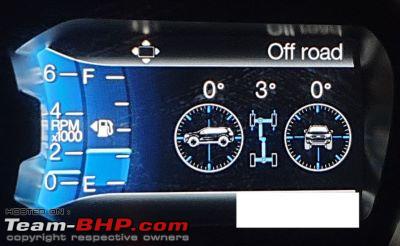 Q27) Where are the towing points on my Endeavour and how do I remove the rear towing cap? A27) There are two towing points. There are two recovery points, one front rated to 1.25 of GVM, and one rear rated to 1.0 of GVM. The front is on the passenger’s side and the rear on the right side. The rear towing plastic cap can be taken out using a thin metal pointer stored in OEM tool kit. See attached photo for reference. You need to be gentle or else you can break the plastic locking.  Q28) How do I tow my 4WD to a garage in case of any damage or malfunction? A28) Since the 4WD Endeavour is Full time 4WD, you will need a flat-bed truck. This is not possible everywhere. So the option is to Tow in Neutral with engine on, for max. speed upto 20 kmphr and upto 20 kms. This is by far the biggest drawback of the 4WD endeavour. Remember neutral only disengages the engine from the transmission but not the wheels. In others words, the transmission is at a big risk of damage. Alternatively, a wheel lift towing vehicle may be used if a flatbed towing vehicle is not available. In addition, you should not tow your vehicle from the rear while the front wheels are on the ground. This can damage your vehicle’s transaxle. Q29) What if I am not able to shift to Neutral for any reason? A29) With ignition off, apply the parking brake fully. Lift up the cover in the center console next to the transmission selector lever with a suitable tool. Push down the locking button in the slot and simultaneously move the selector lever out of park (P) and into another gear. 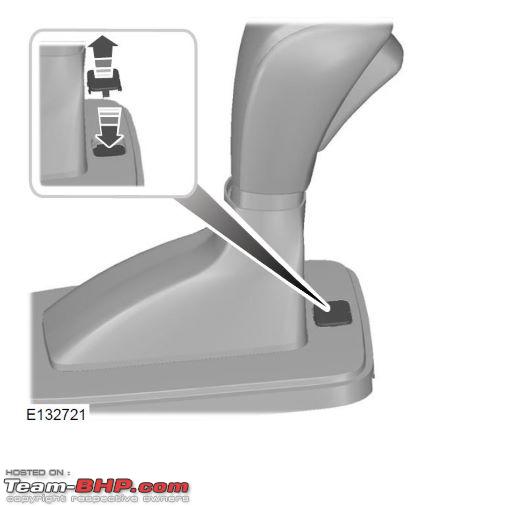 Source: Ford Owner's manual. Q30) Should I replace my stepney with stock size tyre and alloy? A30) Yes. In India, the Endeavour comes with:- A. Tyre size: 265/60R18. B. Rim size: 8jx18 ET55. C. PCD: 6 x 139.7 (6 x 5.5) D: 6 nos. lug nuts on each tyre. Spanner size required - 19 mm. E: Tightening torque for each lug nut: 135 nm. The spare tyre comes with 17 inch steel rim and is rated for max. speed of 80 kmphr. Ideally you should have all 5 same tyres in stock size with the same spare alloy. Spare alloy can be purchased from Ford or from someone who is selling them. The stock size stepney with alloy easily fits the stepney storage area. Q31) Do I need an OBD2 scanner? A31) Yes, if you go for overlanding, off roading and / or cross country drives. However I would not recommend the cheap Ch scanners available online. The particular scanner that you buy, must have the capability to read all DTC codes, as some of these can stall your car and you can be helpless on the road. Some advanced OBD scanners can erase errors. Although the error may resurface, at least you can drive in slow or Limp mode before help arrives or at least to a safe parking spot. Just knowing what the fault is could actually save you. Let’s say you have a C0023 Stop Lamp Control fault. You’re not going to worry about fixing that urgently as it may not stop you from driving. But, you would definitely want to know about P0148 which is fuel delivery error. And even if you can’t fix the fault or understand it, you can at least quote it to someone who can help instead of just saying “Check engine light on my dash”, which can be anything. I use an Innova 6100P purchased from the US, which can read all DTC codes and Ford codes. Another option is Autophix from Australia. There are many available in the market. The choice is yours. 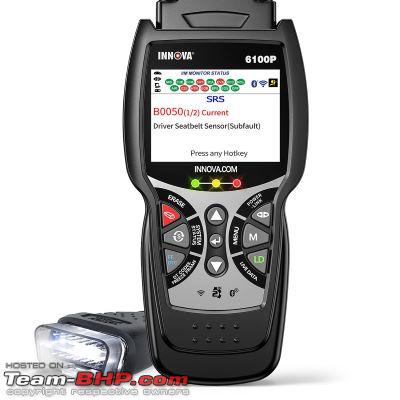 Q32) Do I need to carry a jump starter? A32) Yes, if you go for overlanding, off roading and / or cross country drives. Please note that everything in a modern car is ECU regulated. So "Battery dead = Car dead". You cannot push start your vehicle like olden days. Idea is to have a compatible jump starter, no matter what make. It should be compatible with your engine, as the cranking depends on the jump starter power. I use a Noco jump starter.  Review of Noco: https://www.team-bhp.com/forum/modif...p-starter.html (Review: Noco GB70 jump starter) Q33) What are the tools that I should keep in my 4WD? A33) This is a every subjective question and depends where your vehicle is going. Some of the tools I have are:- • Jump starter (Noco, USA). https://no.co/gb70 • Innova 6100P OBD2 reader (Innova, USA). https://www.innova.com/ • Recovery strap with shackles and gloves (TJM, Australia).https://www.tjm.com.au/catalog/produ...tegory/119425/ • Two soft shackles (Rhino, USA). • Pair of Sand ladders (Maxtrax, Australia). https://www.maxtrax.com.au/product/m...nature-orange/ • CKMP12 tyre inflator (ARB, Australia). https://www.arb.com.au/site/wp-conte...21/01/3-05.pdf • Michilin tyre inflator. https://www.amazon.in/Michelin-12266...=1&ext_vrnc=hi • Coido tyre pressure gauge. https://www.amazon.in/Coido-Pressure.../dp/B00RMFF1EQ • Tyre deflator & pressure gauge (ARB, Australia). https://air90.com/products/arb-e-z-tyre-deflator-kit • Tyre repair kit. • Spare tyre valve (Local from tyre shop). • Spare tyre sensor (Ford). • Tyre valve remover. https://www.amazon.in/Tirewell-TW-50...e%2C261&sr=1-3 • Emergency valve (Colby, USA). https://www.colbyvalve.com/ • Mechanical tyre thread measurer. • 10 nos. spare tyre nuts/lug nuts (Ford). • Torque spanner rated from 28-210 nm torque. • Shovel. • Crow bar (small). https://www.amazon.in/Python-Wreckin...=1&ext_vrnc=hi • Spare car key remote battery. • Emergency glass breaker (fitted on the pillar behind driver seat). • Various tools like – Fuse remover, Spanners, shifter, masking tape, screw drivers, cable ties, large rubber bands, microfiber cloth, T spanners, allen keys, quick fast solutions. Future plans - Exhaust jack, farm jack, Anti-theft nuts. Note: 1) The author is not an automobile engineer, motorsports expert or a professional offroader. 2) The information is compiled from various sources like Owner's manual, online articles, videos and personal obervations and experimentation done on a self owned 3.2 Endeavour. The Aussie articles and videos have particularly been very helpful. 3) During offroad, drive as slow as possible and as fast as required. 4) The Q&A section is only for guidance and reference only. 5) The Q&A does not replace the details given in the company Owner’s manual and/or Factory manual. 6) The author is not responsible for any unforeseen circumstances, in case tips from here are followed. You are responsible for your own vehicle. Last edited by ruzbehxyz : 2nd March 2022 at 17:05. |
| |  (55)
Thanks (55)
Thanks
 |
| The following 55 BHPians Thank ruzbehxyz for this useful post: | abirnale, Ace F355, ankushbansal, AROO7, ashking101, AutoNoob, AVR, Bibendum90949, BopsKA12, CaptainKG, catchjyoti, CEF_Beasts, Cyborg, dhanushs, D_Security_Guy, evil_grin, gischethans, GTO, gunin, IcarusMan, jomson13, Karthik Chandra, kevintomin, Kosfactor, lovetorque, MithunSathianat, mugen_pinaki27, Nature&Me, neel@makrand, NewUser123, nightraven, One, petrogeek, Prakritij, pratika, PrideRed, rachitarora1985, Ranger747, RedTerrano, rjcorona, Route66, rtdp, Samba, sauravpat, Sheel, SILVER-ARROW, SS-Traveller, SukhamritR, Surprise, theexperthand, Turbanator, Venkatesh, Venom_rider, VinNam, WhiteKnight |
| | #9 |
| Team-BHP Support  | re: Understanding 4x4 and Modern 4WD driving aids Mod note: Thread moved to 4X4 Technical section. Thanks for sharing. |
| |  (5)
Thanks (5)
Thanks
 |
| The following 5 BHPians Thank Rudra Sen for this useful post: | Bibendum90949, dhanushs, GTO, ruzbehxyz, Samba |
| | #10 |
| Senior - BHPian Join Date: Feb 2005 Location: Chennai
Posts: 2,523
Thanked: 454 Times
| re: Understanding 4x4 and Modern 4WD driving aids @ruzbehxyz. Thanks for the effort that has gone in to create this thread. Will help many to understand the basics and how the systems work. |
| |  (1)
Thanks (1)
Thanks
 |
| The following BHPian Thanks Surprise for this useful post: | ruzbehxyz |
| | #11 | |
| Distinguished - BHPian  Join Date: Oct 2009 Location: Chennai
Posts: 4,280
Thanked: 10,171 Times
| Re: Understanding 4x4 and Modern 4WD driving aids Thanks for a very detailed thread on modern 4WD driving aids. I'd like to add one more modern 4WD feature, which we are yet to see in India, but are being retrofitted in competition cars and is also very popular in Jeep and Ford in the US. The Trail Turn Assist. Basically it applies brakes to the inner wheel during a turn, so that the vehicle has a shorter turning radius. Quote:
Here's one of my builds with the feature. | |
| |  (8)
Thanks (8)
Thanks
 |
| The following 8 BHPians Thank dhanushs for this useful post: | Bibendum90949, BopsKA12, Kosfactor, megazoid, ruzbehxyz, Samba, SS-Traveller, theexperthand |
| |
| | #12 | |
| BHPian | Re: Understanding 4x4 and Modern 4WD driving aids Quote:
| |
| |  (1)
Thanks (1)
Thanks
 |
| The following BHPian Thanks megazoid for this useful post: | ruzbehxyz |
| | #13 | ||
| Senior - BHPian Join Date: Oct 2014 Location: MH02 to MH46
Posts: 1,612
Thanked: 6,596 Times
| Re: Understanding 4x4 and Modern 4WD driving aids Quote:
Toyota, on the other hand, has a similar system to Trail Turn Assist in the full-size Land Cruiser but it’s marketed as Turn Assist Control. Quote:
Last edited by ruzbehxyz : 3rd March 2022 at 10:21. | ||
| |  (2)
Thanks (2)
Thanks
 |
| The following 2 BHPians Thank ruzbehxyz for this useful post: | megazoid, Samba |
| | #14 |
| Distinguished - BHPian  Join Date: Oct 2009 Location: Chennai
Posts: 4,280
Thanked: 10,171 Times
| Re: Understanding 4x4 and Modern 4WD driving aids |
| |  (4)
Thanks (4)
Thanks
 |
| The following 4 BHPians Thank dhanushs for this useful post: | Bibendum90949, megazoid, ruzbehxyz, Samba |
| | #15 |
| BHPian Join Date: Feb 2020 Location: Mumbai-Pune
Posts: 58
Thanked: 113 Times
| Re: Understanding 4x4 and Modern 4WD driving aids @ruzbehxyz. Thank you for this detailed explanation. One can learn much more from this. Excellent. I only wish Jeep could have offered Compass or atleast one model under Trailhawk diesel 4x4 in manual transmission with cruise control. It would have been excellent variant for many. |
| |  (1)
Thanks (1)
Thanks
 |
| The following BHPian Thanks Sachin V.W. for this useful post: | ruzbehxyz |
 |


